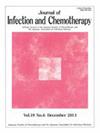Carbon dioxide-dependent, extended-spectrum β-lactamase producing Escherichia coli bacteremia associated with pyelonephritis: A case-report
IF 1.9
4区 医学
Q3 INFECTIOUS DISEASES
引用次数: 0
Abstract
Escherichia coli is a facultative anaerobic bacterium that causes urinary tract and bloodstream infections. Generally, E. coli is easily identified in routine clinical microbiology laboratories. Herein, we report a case of pyelonephritis with bacteremia due to extended-spectrum β-lactamase (ESBL) producing E. coli, which delayed the identification of the isolate as it exhibited carbon dioxide (CO2)-dependent growth. The patient was a 62-year-old man who presented with nausea and an altered mental status. Contrast-enhanced computed tomography revealed multiple abscesses in the left kidney. The anaerobic bottles of the two sets of blood cultures were positive, but growth on a routine aerobic culture was weak. Identification of the isolate was delayed because it grew only on agar plates incubated in a 5 % CO2 atmosphere. The isolate was suspected to be an ESBL-producing strain based on antimicrobial susceptibility testing, which was confirmed by polymerase chain reaction analysis. The patient was successfully treated with administering meropenem and nephrectomy. To the best-of-our-knowledge, this is the first reported case of a human infection caused by ESBL-producing carbon-dioxide-dependent E. coli.
二氧化碳依赖性广谱β-内酰胺酶产生的大肠埃希菌菌血症伴肾盂肾炎:病例报告。
大肠杆菌是一种兼性厌氧细菌,可引起尿路和血液感染。一般来说,大肠杆菌很容易在常规临床微生物实验室中被鉴定出来。在此,我们报告了一例由产广谱β-内酰胺酶(ESBL)大肠杆菌引起的肾盂肾炎并伴有菌血症的病例,由于大肠杆菌表现出二氧化碳(CO2)依赖性生长,因此延误了对分离菌的鉴定。患者是一名 62 岁的男性,出现恶心和精神状态改变。对比增强计算机断层扫描显示左肾有多处脓肿。两组血液培养的厌氧瓶均呈阳性,但常规需氧培养的生长很弱。由于分离菌只在 5% CO2 环境下培养的琼脂平板上生长,因此鉴定工作被推迟。根据抗菌药敏感性检测结果,怀疑该分离菌株为产 ESBL 菌株,聚合酶链反应分析证实了这一点。通过使用美罗培南和肾切除术,患者得到了成功治疗。据我们所知,这是首例报告的由产 ESBL 二氧化碳依赖性大肠杆菌引起的人类感染病例。
本文章由计算机程序翻译,如有差异,请以英文原文为准。
求助全文
约1分钟内获得全文
求助全文
来源期刊

Journal of Infection and Chemotherapy
INFECTIOUS DISEASES-PHARMACOLOGY & PHARMACY
CiteScore
4.10
自引率
4.50%
发文量
303
审稿时长
47 days
期刊介绍:
The Journal of Infection and Chemotherapy (JIC) — official journal of the Japanese Society of Chemotherapy and The Japanese Association for Infectious Diseases — welcomes original papers, laboratory or clinical, as well as case reports, notes, committee reports, surveillance and guidelines from all parts of the world on all aspects of chemotherapy, covering the pathogenesis, diagnosis, treatment, and control of infection, including treatment with anticancer drugs. Experimental studies on animal models and pharmacokinetics, and reports on epidemiology and clinical trials are particularly welcome.
 求助内容:
求助内容: 应助结果提醒方式:
应助结果提醒方式:


